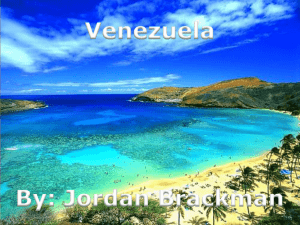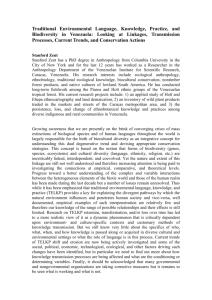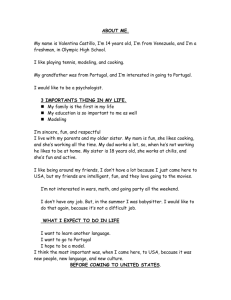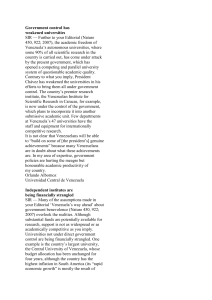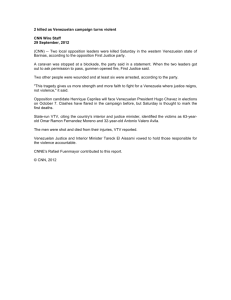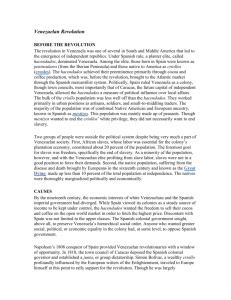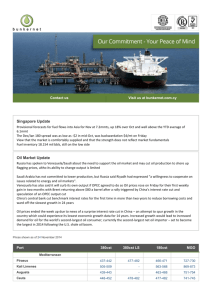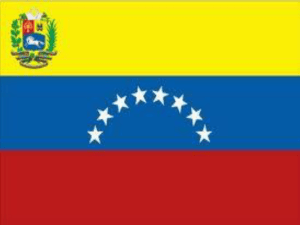Venezuelan Communism and International Intervention, 1964
advertisement
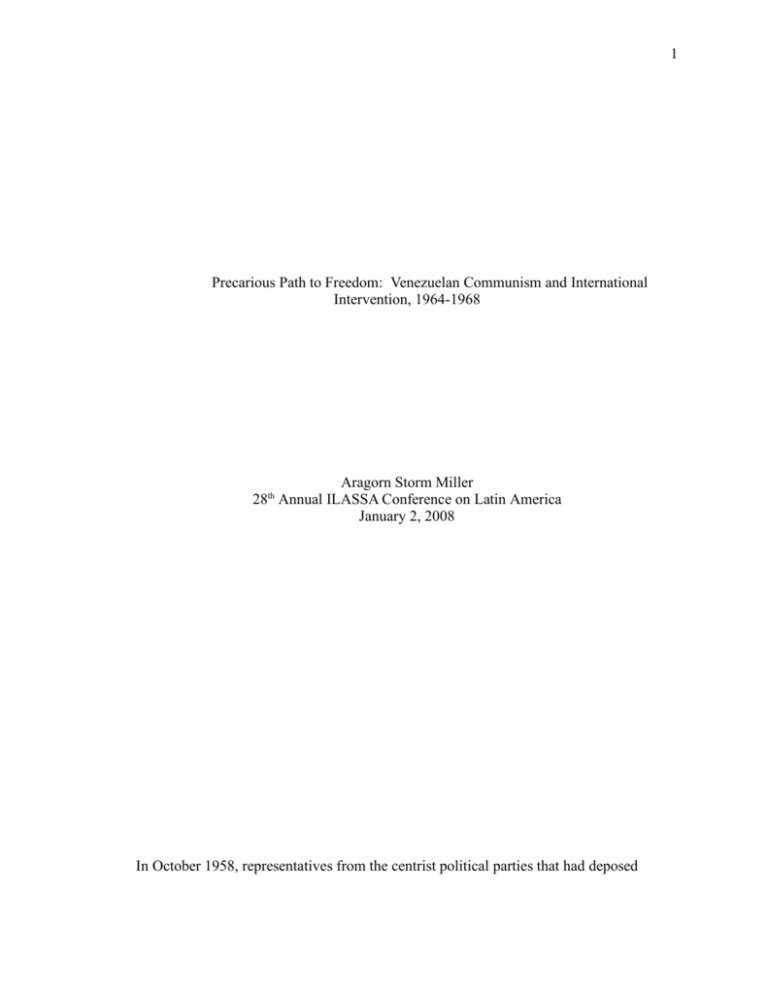
1 Precarious Path to Freedom: Venezuelan Communism and International Intervention, 1964-1968 Aragorn Storm Miller 28th Annual ILASSA Conference on Latin America January 2, 2008 In October 1958, representatives from the centrist political parties that had deposed 2 Venezuela dictator Marcos Pérez Jiménez formalized a power sharing arrangement and excluded the Venezuelan Communist Party (PCV) from the governing coalition. Following this ostracism, the PCV and other local communists agitated for inclusion through violent and peaceful methods that both invoked and influenced debates within the international Cold War environment. The first phase of this proxy struggle concluded in November 1963, when Venezuelan authorities unearthed a three-ton arms cache along a beach in that country’s Paraguana Peninsula. The seizure of these Cuban-supplied weapons constituted a critical blow against the campaign by Venezuelan communists to disrupt the upcoming presidential elections and highlighted the inability of Venezuelan communism to reinsert itself into national politics. In many ways, this outcome was improbable. The movement enjoyed bright prospects in 1958, benefiting from internal unity, the example provided by Fidel Castro’s Revolution, and material support from international communists. Yet in the course of the 1960s the movement became splintered, vulnerable, and impotent, in its struggle against the Venezuelan government. This study analyzes events associated with the movement between 1964 and 1968 in an effort to explain why this splintering and failure occurred.1 In early 1964, Venezuelan communists regrouped to fashion a new campaign against the government, downplaying internal disagreements concerning future peaceful or violent methods. Similar ideological fraying among the communists’ domestic and global allies and opponents prevented such incipient fissures from threatening the movement. A succession of failures for the Venezuelan movement, however, turned these cracks into gaping rifts, while within the international community a critical consensus emerged for moderate politics at the expense of 1 This essay is an abridged version of a much longer paper designed to be the foundation for my Master’s Report. I will happily provide the longer paper as well as any additional evidence or research to support my conclusions; I can be contacted at asm667@mail.utexas.edu. 3 radical action. By 1968, the irreconcilably polarized movement lingered at the fringes of a prohibitively powerful center. The Venezuelan communist movement failed, therefore, because a series of setbacks fostered disunity and weakness in the face of a unified and coherent enemy. This episode merits study because it fills a historiographical gap and speaks to fundamental debates of intra and international politics and statecraft. Scholarship has addressed U.S. efforts at containment of Cuba, the efforts of centrist Venezuelans at state-building, and often-tenuous relationship between Fidel Castro and his Soviet sponsors; yet no study establishes Venezuelan communism at the center of a multilateral contest during a pivotal moment in the Cold War, and casts Venezuela as a forum for the tailoring of revolutionary and counterrevolutionary tactics and strategies.2 The failure of the revolution in Venezuela did not foreclose revolutions elsewhere, but rather demonstrated the difficulties associated with maintaining revolutionary unity and the dangers of disunity in the face of a determined counterrevolutionary force.3 In April 1964, the PCV convened to discuss the election of 1963 and the current political environment.4 Prior to the election the Party had waffled between negotiating with the legal 2 Here I refer to William O. Walker III, “Mixing the Sweet with the Sour: Kennedy, Johnson, and Latin America,” in The Diplomacy of the Crucial Decade: American Foreign Relations during the 1960s, ed. Diane B. Kunz (New York: Columbia University, 1994); Stephen G. Rabe, The Most Dangerous Area in the World: John F. Kennedy Confronts Communist Revolution in Latin America (Chapel Hill: University of North Carolina, 1999); William A. Hazleton, “Colombian and Venezuelan Foreign Policy: Regional Powers in the Caribbean Basin,” in Donald L. Herman, ed. Democracy in Latin America: Colombia and Venezuela (New York: Praeger, 1988). 3 In revealing Venezuela’s role as a political catalyst, this study relies almost exclusively on primary sources generated by the United States government. Such reliance poses methodological problems in terms of scope and perspective. The minute behavior and experiences of actors within Cuba and Venezuela becomes opaque; correspondence between U.S. operatives and bureaucrats must be assumed to skew toward U.S. interests and imperatives. Yet because this study endeavors to provide a story of local characters playing key roles on a global stage, and because of limitations on the availability of documents, such an approach is necessary. To combat these shortcomings, I have favored those documents that appear to be the most impartial while putting them in conversation with documents favoring the more extreme leftist or right wing positions. 4 The 1958 Punto Fijo Pact had committed the centrist Democratic Action (Acción Democratica, or AD), Social Christian (Comité de Organización Política Electoral Independiente, or COPEI), and Democratic Republican Union (Unión Republicana Democrática, or URD) parties to a ruling coalition following the overthrow of dictator Marcos Pérez Jiménez. This coalition excluded the Venezuelan Communist Party 4 opposition and boycotting the election; the Armed Forces of National Liberation (FALN) had engaged in sensational but ineffective urban terrorism. The PCV Central Committee concluded that the failure of the combined peaceful-armed effort to disrupt the election resulted from poor timing and execution rather than from any flaw in strategy. Agreeing on the past, however, proved easier than finding common ground for the future. Because of the setback encountered during the election, hard-liners and soft-liners felt equally justified in advancing their beliefs. As a means of compromise, the Central Committee agreed to refine the unified peaceful-violent national front strategy. Violence and politics would work in tandem. Yet the exact relationship and timing between these tactics was not expressly stated.5 This domestic tension mirrored the international communist scene, where Soviet, Chinese, and Cuban attitudes existed in relative opposition and balance. At the end of 1959, a schism developed between Soviet Premier Nikita Khrushchev and Chairman of the People’s Republic of China Mao Tse Tung over the proper orientation of communist policy. This SinoSoviet split contributed to divisions in communist parties throughout the world. The “violent” strategy espoused by China—and echoed by Cuba—held great appeal for its apparent dynamism and vigor within Venezuela and the broader developing world. Yet Soviet methods of gradualist politicking found surrogates as well. Consequently, revolutionaries confronted a methodological (Partido Comunista de Venezuela, or PCV). Despite this exclusion, the PCV continued to adhere to the via pacifica, a peaceful strategy of electoral participation modeled along directives from Moscow. In July 1960, the Marxist wing of AD was kicked out of the party. Styling themselves the Movement of the Revolutionary Left (Movimiento de la Izquierda Revolucionaria, or MIR), this faction asserted lucha armada, or armed struggle against the government according to a Castroist or Maoist model. The PCV and the MIR soon united in opposition to the government, as the National Liberation Front (Frente de Liberación Nacional, or FLN). This front carried out armed action through the Armed Forces of Nation Liberation (Fuerzas Armadas de Liberación Nacional, or FALN), a collection of urban and rural guerilla fighters. As we will see, the orientation of these groups varied considerably, but one can maintain a basic feel for the action by remembering the categories “peaceful-PCV” and “violent-MIR.” 5 Central Intelligence Agency [hereafter cited as CIA] Intelligence Information Cable, “Conclusions of the Fifth Plenum of the Central Committee of the Communist Party of Venezuela,” 19 May, 1964. National Security File, Country File [hereafter cited as NSF, CF]: Venezuela, Box 74, Cables, Vol. I, 11/63–7/64. Lyndon Baines Johnson Presidential Library [hereafter cited as LBJ Library]. 5 dilemma in their quest to hasten the victory of world socialism.6 Such a situation gave creative energy to the Venezuelan communist movement, but also hindered its ability to progress. For Venezuela president-elect Raul Leoni, the way forward appeared equally murky as he prepared to succeed Rómulo Betancourt. Leoni subscribed to Betancourt’s efforts to institutionalize multiparty, democratic governments in Latin American politics. By calling for the non-recognition of regimes that overthrew constitutionally elected governments, however, this Betancourt Doctrine placed Venezuela at odds with the new communist dictatorship in Cuba.7 While this enmity suggested a natural alliance with the United States, Leoni harbored significant reservations about U.S. commitment tot developing democratic institutions rather than deposing them.8 In Washington, consensus remained similarly elusive. Policymakers believed hemispheric communism and Castro to be viable for the foreseeable future, and thus sought to quarantine Cuba diplomatically and ensure that the armed forces of regional allies remained competent if not robust. Yet despite signs of fragility the Leoni government appeared to provide enough stability to prevent the communists from taking power through violence or political participation.9 These developments set the stage for a new round of conflict. Each side felt confrontation to be necessary and felt secure enough in its methods to eschew innovation. The lack of clarity in this environment, however, hampered the ability of the forces in action to gauge either their own strength or that of their enemies. 6 Deputy Chief of Mission, U.S. Embassy in Venezuela John C. Hill, Jr., State Department Telegram, U.S. Embassy in Caracas to Washington, 5 Sep, 1964. NSF, CF: Venezuela, Box 75, Cables, Vol. II, 8/64– 8/66. LBJ Library. 7 William A. Hazleton, “Colombian and Venezuelan Foreign Policy: Regional Powers in the Caribbean Basin,” in Democracy in Latin America: Colombia and Venezuela, ed. Donald L. Herman (New York: Praeger Publishers, 1988), 249. 8 State Department Telegram. U.S. Embassy in Caracas to Washington, 24 Mar, 1964. NSF, CF: Venezuela, Box 74, Cables, Vol. I, 11/63–7/64. LBJ Library. 9 CIA National Intelligence Estimate, NIE 89-64, “Prospects for Political Stability in Venezuela,” 19 Feb, 1964. Foreign Relations of the United States, 1964-1968, vol. XXXI, South and Central America; Mexico (Washington: United States Government Printing Office, 2004) [hereafter cited as FRUS 19641968, South and Central America], 1081-1084. 6 In July 1964, the foreign ministers of the American Republics met in Washington to consider the Venezuelan complaint associated with the arms cache discovery. While the United States sought an open-ended resolution to use force against Castro in the case of any similar subversion, the final resolution provided a muted diplomatic censure.10 Because hemispheric communists appeared to maintain a low profile, however, Washington adopted a posture of cautious optimism.11 By September 8, Chile, Bolivia, and Uruguay had joined the OAS resolution and severed their diplomatic ties with Cuba, leaving Mexico as the sole member still in contact with the island. The crisis arising from the discovery of Cuban arms on Venezuela’s Paraguana Peninsula appeared at least partially resolved. While diplomatic efforts to isolate Cuba proceeded, a new communist offensive in Venezuela was imminent. Pursuant to the PCV and FALN agreement that peaceful prepping should precede armed action, the PCV initiated an intensive ideological advertisement of the party in order to demonstrate the illegitimacy and instability of the Leoni coalition government. The masses, according to the plan, would realize that the government failed to represent their interests and demand that the PCV be included in the political process. Upon government rejections of such demands, the masses would support the resumption of FALN attacks. By the end of the summer, however, Leoni’s coalition appeared successful and stable. Communist policy now reversed itself. Rather than wait for peaceful creation of ideal revolutionary conditions, the FALN planned to engage in violent action and create space for later political exploitation.12 At the end of September FALN fighters launched attacks throughout the nation. In the 10 The Department of State Bulletin, Vol. 51, No. 1311, August 10, 1964 (Washington, D.C.: U.S. Government Printing Office, 1964), 174-190. 11 Summary Record of the 536th Meeting of the National Security Council, 28 Jul, 1964. FRUS 19641968, South and Central America, 63. 12 CIA Intelligence Information Cable, “Communist Decision to Start a Guerilla and Terrorist Offensive as Soon as Possible,” 6 Sep, 1964. NSF, CF: Venezuela, Box 74, Cables & Misc. LBJ Library. 7 most spectacular action, FALN terrorists kidnapped U.S. Air Force Chief of Mission Lieutenant Colonel Michael Smolen outside of his Caracas residence on October 9.13 The FALN, however, found that their campaign rapidly turned into a fiasco. Smolen was released on October 12, but DIGEPOL, the Venezuelan state police, discovered the apartment where he had been held. Evidence at this site led to the arrest of 29 key FALN members involved in at least twenty high profile terrorist actions since 1962.14 By late October, PCV officials shut down two entire guerilla brigades because their commanders were now under arrest. Further, the police crackdown emanating from the kidnapping caused the PCV leadership to question the judgment and competency of FALN leaders; mid-level members of both organizations began to doubt whether the popular front framework could be maintained.15 While the dust from this abortive campaign settled, international communists leaders met in Havana in November 1964 to discuss the prospects of the movement in Venezuela and the state of world communism. Soviet party leaders had deposed Premier Nikita Khrushchev in mid-October, and now focused on smoothing over the divisions arising from the Sino-Soviet split. Rather than demand that developing nations declare their loyalty to the USSR or to China, the Soviets recognized the right of “fraternal parties” to pursue their own independent “patriotic” programs based on their evaluation of local conditions.16 While Venezuelan efforts gained approbation, this agreement also carried a tinge of resignation by the Soviets. With no official presence in Caracas, and with Castro openly declaring the Venezuelan situation to be his highest 13 Special Assistant to the President for National Security Affairs McGeorge Bundy to Special Assistant to the President Jack Valenti, State Department Telegram, 9 Oct, 1964. NSF, CF: Venezuela, Box 75, Cables, Vol. II, 8/64-8/66. LBJ Library. 14 State Department Telegram, Embassy in Caracas to Washington, “Joint Week[ly Update] No. 44],” 30 Oct, 1964. NSF, CF: Venezuela, Box 75, Cables, Vol. II, 8/64-8/66. LBJ Library. 15 CIA Intelligence Cable, “Dissatisfaction within the Communist Party Toward Party Leaders/Future Plans of the FALN to Continue Terrorism Despite Police Crackdown,” 28 Oct, 1964. NSF, CF: Venezuela, Box 75, Cables, Vol. II, 8/64-8/66. LBJ Library. 16 CIA Intelligence Study, “Foreign and Domestic Influences on the Venezuelan Communist Party, 1958– Mid-1965,” 6 Dec, 1965. NSF, CF: Venezuela, Box 75, Cables & Misc. Vol. II, 8/64–8/66. LBJ Library. 8 priority, Moscow realized that continued insistence on peaceful methods simply hastened the moment at which it would be forced out of the Venezuelan arena. In April 1965, the PCV leadership launched a new campaign to win Venezuelan hearts and minds. Meanwhile, in keeping with the unified-action theme discussed in the spring of the previous year, the FALN sent “action-teams” into these foreign-owned facilities, sabotaging oil lines and generally destroying any property or targets of opportunity.17 Once again, however, the FALN failed to unseat government authority, and engendered a harsh government crackdown that threatened the survival of the entire communist movement. Following the end of the 1965 campaign, the PCV expanded its information campaign, stressing the need for both a respite and an embrace of more effective and gradualist methods. Foremost, the party line held that the party apparatus was in shambles; the worn down state of the party made it impossible to engage with various leftist and labor parties and, in so doing, actually play a meaningful role in national politics.18 The inherent tensions within the movement finally ruptured. On December 29, 1965, hard-liners within the FALN, including Douglas Bravo, Jose Rafael Nunez Tenorio, and Pasqueir Suarez, declared themselves in open opposition to the established communist structure. In addition to forming a separate, parallel structure to the FALN, these dissidents also formed a union with a dissident faction from the MIR. In the face of this development, and the plans of the dissidents to resume terrorist activities in the first months of 1966, the main-line PCV and FALN issued criticism but remained essentially powerless, passive, and inert.19 The endorsement 17 CIA Intelligence Information Cable, “Communist Plans for Anti-American Terrorism Throughout Venezuela,” 8 May, 1965. NSF, CF: Venezuela, Box 75, Memos & Misc. Vol. II, 8/64-8/66. LBJ Library. 18 CIA Intelligence Memorandum, “The Venezuelan Communist Split and Present Insurgency,” 7 Jun, 1967. NSF, CF: Venezuela, Box 75, Memos & Misc. (2 of 2) Vol. III 12/66-12/68. LBJ Library. 19 CIA Intelligence Information Cable, “Revolt of Hard-Line Dissidents in the FALN Against Established Leadership, and Plans of the Rebels to Resume Terrorism in Caracas in January 1966,” 30 Dec, 1965. NSF, CF: Venezuela, Box 75, Memos & Misc. Vol. II, 8/64-8/66. LBJ Library. 9 of armed struggle appeared to be confirmed on January 6, 1966, when Sharaf R. Rashidov, head of the Soviet delegation, addressed the Tri-Continental Congress then meeting in Havana. The basic aim of the congress had been to unite Latin American, African, and Asian revolutionaries in their struggle against Western imperialism, and the tone of this meeting mimicked the hardline armed struggle strategy.20 Yet while the Soviets publicly approved of armed struggle, they were in fact retiring from the revolutionary field in Latin America. Indeed, this congress appeared to be a moment in which the revolutionaries of the developing world asserted themselves with much more vigor than the established communist powers. Now independent, the dissident hardliners led by Bravo—approximately 200 men— located themselves in and around Caracas’ Central University.21 In December, however, the Leoni government instituted a crackdown at the university. During the Betancourt administration, Central University enjoyed great autonomy from government police power. With the government crackdown, university residences that had housed communist agitators were closed and converted into classrooms, and government police now patrolled the campus, replacing relatively passive university authorities. On January 27, 1967, former Interior Minister, and current Secretary General of the AD party, Gonzalo Barrios, declared the communist presence on campus to be terminated once and for all.22 At the end of 1966, the communist movement in Venezuela sustained a clear political and physical split. The PCV, the advocates of peaceful methods since the beginning of the struggle against the Pérez Jimenéz dictatorship, concentrated their activity in Caracas and prepared to participate in some fashion in the December 1968 elections. The new FALN dissidents, on the 20 Head of Soviet Delegation Sharaf R. Rashidov, Speech to the Tri-Continental Conference, 6 Jan, 1966. National Security File, Intelligence File, Guerilla Problem in Latin America. LBJ Library. 21 CIA Intelligence Memorandum, “The Venezuelan Communist Split and Present Insurgency,” 7 Jun, 1967. NSF, CF: Venezuela, Box 75, Memos & Misc. (2 of 2) Vol. III 12/66-12/68. LBJ Library. 22 U.S. Ambassador to Venezuela Maurice M. Bernbaum to Washington, State Department Telegram, 31 Jan, 1967. FRUS 1964-1968, South and Central America, 1117-1118. 10 other hand, unequivocally rejected political participation. The revolution would have to be manufactured after all. Now without a sanctuary in the capital city, Bravo and his fighters moved into the countryside to prepare for new revolutionary campaigns. For the time being, such a stark split did not imperil the hard-liners. The fighters demonstrated their ability to maintain themselves against government forces, and the political environment within Venezuela and the wider world did not explicitly favor or discriminate against any one faction. During the spring of 1967, however, a series of realignments occurred that pushed the hard-liners to the margins of society and into the political wilderness. On June 25, 1967, during the U.S.-Soviet Glassboro summit, U.S. President Lyndon Johnson raised the issue of Cuban subversion in Latin America with Soviet Premier Alexei N. Kosygin. Johnson maintained that this activity threatened hemispheric and world peace and intimated that the Venezuelan government had resolved to put a stop to such activity. Though Kosygin did not respond directly to this overture, he did promise to keep these issues in mind during his upcoming meetings with Castro and, in Johnson’s opinion, revealed his commitment to circumscribing Cuban action. Just as the 1966 communist split formalized a de facto situation, the Glassboro Summit in effect put the official seal on developments that had been in play for years. The United States and the Soviet Union observed an unofficial rapprochement, allowing the Cold War to play out via proxy. Significantly, while Johnson expressed his concerns to his Soviet counterpart, he had already made the decision to fundamentally alter the Venezuelan military posture toward that country’s communist insurgency. Both he and Venezuela President Raul Leoni perceived the limits of diplomatic quarantine and conventional force; highly motivated guerillas represented a serious threat to national stability. In this environment the fracture within the Venezuelan communist movement finally proved fatal to the extremist wing. 11 The hard-line posture of Cuba and the dissidents, combined with what appeared to be a retiring posture by the Soviets, led Johnson and Leoni to agree in the spring of 1967 to solve conclusively the communist threat in Venezuela. At a reception prior to an April summit of American Chiefs of State in Punta del Este, Uruguay, Leoni introduced the matter of the new guerilla threat, claiming that Venezuela would be the target of intensified communist aggression in the run-up to the 1968 elections. Referring to recent work by Venezuelan and U.S. authorities, Leoni proposed that the two countries arrange a special outlay of equipment—outside of regular channels—to be delivered at a greatly accelerated pace. In response, Johnson asked precisely what sort of equipment Leoni had in mind, noting that the escalation of the war in Vietnam placed an increasing strain on U.S. materiel supplies. Leoni emphasized that Venezuelan interest lay less in high-tech equipment than in extra supplies of ammunition and transportation and communication equipment. Johnson noted two problems, the first being the overall reduction in Latin American military outlays by Congress, and the second being the unwillingness of the administration “to be the arms merchants of the world.” On the other hand, Johnson concluded, “we do not want the communists to take over Venezuela.” Accordingly, if Leoni could provide a detailed and specific list of equipment, Johnson promised to review it with the Venezuelan foreign minister. At the end of the day, Johnson emphasized, “we don’t want Venezuela to have to wait one minute to chase the communists.”23 A Department of Defense team traveled to Venezuela and set to work on implementing this agreement between Leoni and Johnson immediately. By April 26, a contingent of DOD officials competed planning for, in the words of Ambassador Bernbaum, for ten “new Rangertype battalions,” to be fully equipped and trained in anti-guerilla operations.24 Because of this 23 Memorandum of Conversation Between U.S. President Lyndon Johnson and Venezuela President Raul Leoni, “Venezuelan Requirements for Additional Military Equipment,” 11 Apr, 1967. NSF, CF: Venezuela, Box 75, Filed by LBJ Library. LBJ Library. 24 Ambassador Bernbaum, State Department Telegram, 27 Apr, 1967. NSF, CF: Venezuela, Box 75, Memos & Misc. (2 of 2), Vol. III 12/66-12/68. LBJ Library. 12 accelerated pace, the State Department predicted that six battalions—approximately half of the projected 3600-man force—would be in action by December 1967.25 Meanwhile, the Castrosupported dissidents continued to engage in limited action throughout the remainder of 1967. While the PCV had reacquired Soviet funding in February, the FALN splinter relied totally on Cuban support. Castro reinforced the dissidents with a series of landings, including the May 8 capture that led to the Johnson-Kosygin interview. Yet the isolated fighters found it increasingly rough going in the literal and figurative wilderness. The lack of a large body of urban peasantry limited the ability of the fighters to feed themselves and win adherents, and Venezuela’s autumn rainy season compelled the guerillas to operate in areas patrolled by government forces.26 After the ranger battalions came on line during the winter of 1967-1968, any real chance for the communist dissidents to disrupt Venezuelan politics ceased, as the remaining fighters became further divided amongst themselves and unable to counter the improved counterinsurgency methods of the government. During the first months of 1968, Bravo had a falling out with Luben Petkoff over tactics and strategy and, upon Petkoff’s departure, redesignated his force the Unified Command FLN/FALN, or CUFF. This force, now down to approximately 60 fighters, continued to operate to the west of Caracas. Further, Bravo’s group was now out of favor with Castro, being denounced on Radio Havana for not being sufficiently aggressive against the government in Caracas. For his part Petkoff had taken his approximately 100 fighters back to the PCV’s erstwhile allies, the Leftist Revolutionary Movement (MIR,) which was now the outlet for Castro’s aid in the region. With materiel support from Cuba, this group retained the capability to carry out sabotage, but in general these units avoided the Venezuelan armed forces for fear of heavy 25 Director of the Bureau of Intelligence and Research, Department of State Thomas L. Hughes to Rusk, “The Insurgency in Venezuela—A Reassessment,” 9 May, 1967. NSF, CF: Venezuela, Box 75, Memos & Misc. (2 of 2), Vol. III, 12/66-12/68. LBJ Library. 26 Bernbaum to Washington, State Department Telegram, 23 Jun, 1967. National Security File, Intelligence File: Guerilla Problem in Latin America. LBJ Library. 13 losses. Discretion proved to be the better part of valor, given that Venezuela possessed, by the autumn of 1968, 13 complete ranger battalions. In addition, the government had undertaken infrastructure and medical facility development project in areas typically beset by guerilla activity, thus providing butter to the population to complement the guns wielded by the armed forces.27 The peaceful communists restyled themselves as well. Fully reconciled with the Soviet Union, the PCV remained committed to participating in the 1968 elections under a new front, the Union for Advancement. Like the 1964 election, the 1968 election proved anti-climatic. While the PCV campaigned peacefully but ineffectively, far left groups simply observed a boycott.28 Despite a raucous, carnival atmosphere, Rafael Caldera—of the centrist COPEI party—won the election handily with 29 percent of the vote. As Johnson adviser Walt Rostow noted in early December, Caldera would maintain the pro-U.S., anticommunist, orientation of Venezuela.29 Conclusion The collapse of the Venezuelan communist movement demonstrates the saliency of moderate politics and conservatism in the Western hemisphere. This political orientation contributed to leftist revolutionary responses, and these responses drew energy from the intense ideological debates of the Cold War, but in the final analysis the hemisphere remained resistant to radical change. Despite access to an array of resources, peaceful and violent leftists could not unhinge a society committed to centrist politics and supported by the United States. Successive failures forced communists of various stripes to either moderate or sharpen their tactics. In each case moderate political structures and finely tuned coercive forces could assimilate or eliminate these 27 CIA Intelligence Memorandum, “Status of Insurgency in Venezuela,” 13 Oct, 1968. NSF, CF: Venezuela, Box, 75, Memos & Misc. (2 of 2), Vol. III, 12/66-12/68. LBJ Library. 28 Bernbaum to Washington, State Department Telegram, “Venezuelan Elections 1968,” 21 Nov, 1968. NSF, CF: Venezuela, Box 75, Cables, Vol. III, 12/66-12/68. LBJ Library. 29 Walt W. Rostow to the President, White House Memorandum, “Venezuelan Elections,” 9 Nov, 1968. NSF, CF: Venezuela, Box 75, Filed by the LBJ Library. LBJ Library. 14 overtures. Regardless of approach, the Venezuelan and U.S. governments maintained their ability to up the ante against communist encroachment. In the wider world, the vital center of moderation gained strength, as revolutionary powers either toned down their zeal or withdrew from the field. Revolution in the developing world remained possible, but the Venezuelan episode revealed that such revolutions failed more often than they succeeded. Bibliography ARCHIVAL SOURCES The Department of State Bulletin, Vol. 51, No. 1311, August 10, 1964. Washington, D.C.: U.S. Government Printing Office, 1964. Foreign Relations of the United States, 1964-1968, XXXI, South and Central America; Mexico. Washington: United States Government Printing Office, 2004. Lyndon Baines Johnson Presidential Library, Austin, Texas. National Security Files, Country Files: Venezuela (Boxes 74-75); National Security Files: Intelligence Files. New York Times. Perry Castaneda Library. The University of Texas at Austin, Austin, Texas. SECONDARY SOURCES Castro, Fidel. Those Who Are Not Revolutionary Fighters Cannot Be Called Communists. New York: Merit Publishers, 1968. Herman, Donald L., ed. Democracy in Latin America: Colombia and Venezuela. New York: Praeger, 1988. Kunz, Diane B., ed. The Diplomacy of the Crucial Decade: American Foreign Relations during the 1960s. New York: Columbia University, 1994. Rabe, Stephen G. The Most Dangerous Area in the World: John F. Kennedy Confronts Communist Revolution in Latin America. Chapel Hill: University of North Carolina, 1999. Huggins, Martha K. Political Policing: The United States and Latin America. Durham: Duke University, 1998.
